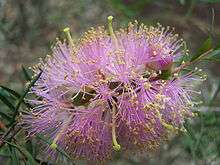Melaleuca radula
Melaleuca radula, commonly known as graceful honey-myrtle, is a plant in the myrtle family, Myrtaceae and is endemic to the south-west of Western Australia. It is an open, spreading shrub with narrow leaves, profuse pink or purple flowers in late winter and smooth, almost spherical fruits.
| Graceful honey-myrtle | |
|---|---|
 | |
| M. radula (cultivated) in Kings Park, Perth | |
| Scientific classification | |
| Kingdom: | Plantae |
| Clade: | Tracheophytes |
| Clade: | Angiosperms |
| Clade: | Eudicots |
| Clade: | Rosids |
| Order: | Myrtales |
| Family: | Myrtaceae |
| Genus: | Melaleuca |
| Species: | M. radula |
| Binomial name | |
| Melaleuca radula | |
Description
Melaleuca radula is a spreading shrub, growing to 5 m (20 ft) tall with coarse bark. Its leaves are arranged in alternating pairs (decussate) so that they make four rows along the branches. The leaves are 10–45 mm (0.4–2 in) long, 0.7–2 mm (0.03–0.08 in) wide, linear to elliptic in shape with the sides turned up so that they are crescent moon-shaped in cross section. There are prominent oil glands on the lower surface.[2][3]
The flowers are white or more usually a shade of pink to mauve. They are arranged in pairs of up to 5, the flowers on opposite sides of the branches forming a spike up to 40 mm (2 in) long and 30 mm (1 in) in diameter. The petals are 4.5–6.5 mm (0.2–0.3 in) long and fall off as the flower matures. There are five bundles of stamens around the flower, each with 30 to 90 stamens giving the spike a fluffy appearance. Flowering mostly occurs from July to September, and is followed by fruit which are woody, almost spherical capsules, 4–6 mm (0.16–0.24 in) in diameter in clusters along the stem.[2][3]
Taxonomy and naming
Melaleuca radula was first formally described in 1839 by John Lindley in an appendix to Edwards Botanical Register entitled A Sketch of the Vegetation of the Swan River Colony.[1] The specific epithet (radula) is derived from Latin word meaning “a scraper”[4] but it is not clear why Lindley chose this name.[2]
| Wikisource has original text related to this article: |
Distribution and habitat
This melaleuca occurs in and between the Kalbarri, Perth and Norseman districts[2] in the Avon Wheatbelt, Coolgardie, Geraldton Sandplains, Jarrah Forest, Mallee, Murchison, Swan Coastal Plain and Yalgoo biogeographic regions.[5] It grows in sandy and gravelly soils often near granite or laterite and near creeks and streams.[6]
Conservation
Melaleuca radula is listed as "not threatened" by the Government of Western Australia Department of Parks and Wildlife.[5]
Aboriginal (Noongar) uses
The leaves were boiled with water to make antiseptic mouthwashes for treating sore gums and for external application to sores and other skin problems. Internally, the decoction was used for upset stomachs and indigestion. Young leaves were chewed for headaches.[7]
The compound, terpinen-4-ol, is thought to be responsible for the antibacterial and antiseptic quality of the melaleuca oil.[7][8]
References
- "Melaleuca radula". APNI. Retrieved 7 June 2015.
- Brophy, Joseph J.; Craven, Lyndley A.; Doran, John C. (2013). Melaleucas : their botany, essential oils and uses. Canberra: Australian Centre for International Agricultural Research. p. 304. ISBN 9781922137517.
- Holliday, Ivan (2004). Melaleucas : a field and garden guide (2nd ed.). Frenchs Forest, N.S.W.: Reed New Holland Publishers. pp. 240–241. ISBN 1876334983.
- Brown, Roland Wilbur (1956). The Composition of Scientific Words. Washington, D.C.: Smithsonian Institution Press. p. 647.
- "Melaleuca radula". FloraBase. Western Australian Government Department of Parks and Wildlife.
- Paczkowska, Grazyna; Chapman, Alex R. (2000). The Western Australian flora : a descriptive catalogue. Perth: Wildflower Society of Western Australia. p. 397. ISBN 0646402439.
- Hansen, V.; Horsfall, J. (2016). Noongar Bush Medicine Medicinal Plants of the South-west of Western Australia. Crawley, WA: IWA Publishing. pp. 82–83. ISBN 9781742589060.
- Lassak, E.V.; McCarthy, T. (2001). Australian medicinal plants. Sydney: New Holland. ISBN 1876334703.